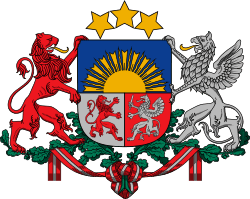Jelgava Palace
| Jelgava Palace | |
|---|---|
 View from the inner yard | |
| General information | |
| Architectural style | Baroque |
| Town or city | Jelgava |
| Country | Latvia |
| Construction started | 1738 |
| Completed | 1772 |
| Client | Ernst Johann von Biron |
| Design and construction | |
| Architect |
Bartolomeo Rastrelli Severin Jensen |
Jelgava Palace (Latvian: Jelgavas pils) or Mitava Palace is the largest Baroque-style palace in the Baltic states. It was built in the 18th century based on the design of Bartolomeo Rastrelli as a residence for the Dukes of Courland in their capital – Mitava (today Jelgava), Latvia. The Dukes of Courland also had a summer palace by Rastrelli nearby called Rundāle Palace.
History

Construction of the palace started in 1738 on an island between the Lielupe river and its branches. The site had borne the residence of the former Courland dukes of the Kettler dynasty and, before that, a medieval castle belonging to the Livonian Order.[1]
Following Ernst Johann von Biron's fall from grace in 1740, all construction work was stopped, even though the roof of the palace had not yet been completed. Most of the building materials and interior elements were moved to St. Petersburg where Rastrelli used them in building of other palaces. Work resumed after Biron's return from exile in 1762. However due to financial difficulties duke moved into palace only in 1772 although interior decorations still was in progress in many rooms. Besides Rastrelli (who, with the death of his patroness, the Empress Elizabeth, lost business in Saint Petersburg), Danish architect Severin Jensen participated in the project,[2] giving the palace a touch of classicism.
After construction was completed in 1772, the duke lived in the palace for six months.[3]In 1779, his successor, Peter von Biron, hosted the famous adventurer Alessandro Cagliostro in the palace. In 1788 part of the palace was damaged by fire.
After Courland was absorbed by the Russian Empire in 1795, the palace served as a refuge for French royalty fleeing the French revolution. Louis XVIII of France and his family lived in the palace between 1798 and 1800.[4] It was here that Marie-Thérèse-Charlotte of France married Louis-Antoine, Duke of Angoulême, in 1799. For the second time King of France incognito lived in the palace from 1804 until 1807. French royalty attempted to recreate the court life of Versailles at Jelgava, where many old courtiers still lived, re-establishing all the court ceremonies, including the lever and coucher (ceremonies that accompanied waking and bedding, respectively)
In the beginning of 19th. century palace became residence of General governor of Courland Governorate. In 1812 for a short time palace became residence for a government of restored Duchy of Courland and Semigallia led by Count von Medem. After Napaleonic wars palace again was occupied by administration of Courland Governorate which was situated there until 1915. In 1815 Northern part of the palace again was damaged by fire.
The interior decorations of the palace were damaged in 1919 when it was looted and burned by retreating West Russian Volunteer Army under the command of Pavel Bermondt-Avalov. Later palace became property of the state and major reconstruction and restoration started. It was decided to establish new university in the palace- Latvia University of Agriculture. It was opened in autumn 1939.
From 1941 until summer of 1944 palace was a residence of Gebietskommissar von Mitau Walter von Medem. The palace suffered heavy damage in World War II, during battles for Jelgava in the summer of 1944. Palace was almost completely destroyed during heavy shelling and street fighting. The exterior of the palace was restored between 1956 and 1964, but not the interior.[1] After restoration The Latvia University of Agriculture again was located in the palace and today it houses university administration and four departments (faculties).
Architecture
Jelgava Palace is not considered one of Rastrelli's better works. Critics note the dull facade design lacking rhythmic diversity and plastic richness which characterized Rastrelli works in the Elizabeth's period. Also, atypically for Rastrelli, the palace does not feature a park; nor is the parade yard closed, rather it faces the urban panorama.
Originally, the palace consisted of two wings connected to the main building forming a U-shape. In 1937 a fourth building was added by Eižens Laube effectively closing the perimeter.[5]
Features of special historical significance include the burial vault of the Dukes of Courland in the south-east basement. All Dukes of Courland from the Houses of Kettler and Biron were buried there between 1569 and 1791. The rooms contain 21 sarcophagi and nine wooden coffins. The crypt was relocated to the palace in 1819.[6]
See also
References
- 1 2 "Jelgava Palace". www.pilis.lv. Retrieved 2009-03-14.
- ↑ Historical buildings and sites in Jelgava
- ↑ Елгавский (Митавский) городской дворец (in Russian).
- ↑ Edward T. Corp, Edward Gregg, Howard Erskine-Hill. A Court in Exile. Cambridge University Press, 2004. ISBN 0-521-58462-0. Page 5.
- ↑ Елгавский дворец (in Russian).
- ↑ "Family Vault of the Dukes of Courland" (PDF).
External links
 Media related to Jelgava Palace at Wikimedia Commons
Media related to Jelgava Palace at Wikimedia Commons
Coordinates: 56°39′21″N 23°43′59″E / 56.6558°N 23.7330°E


